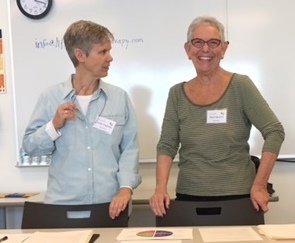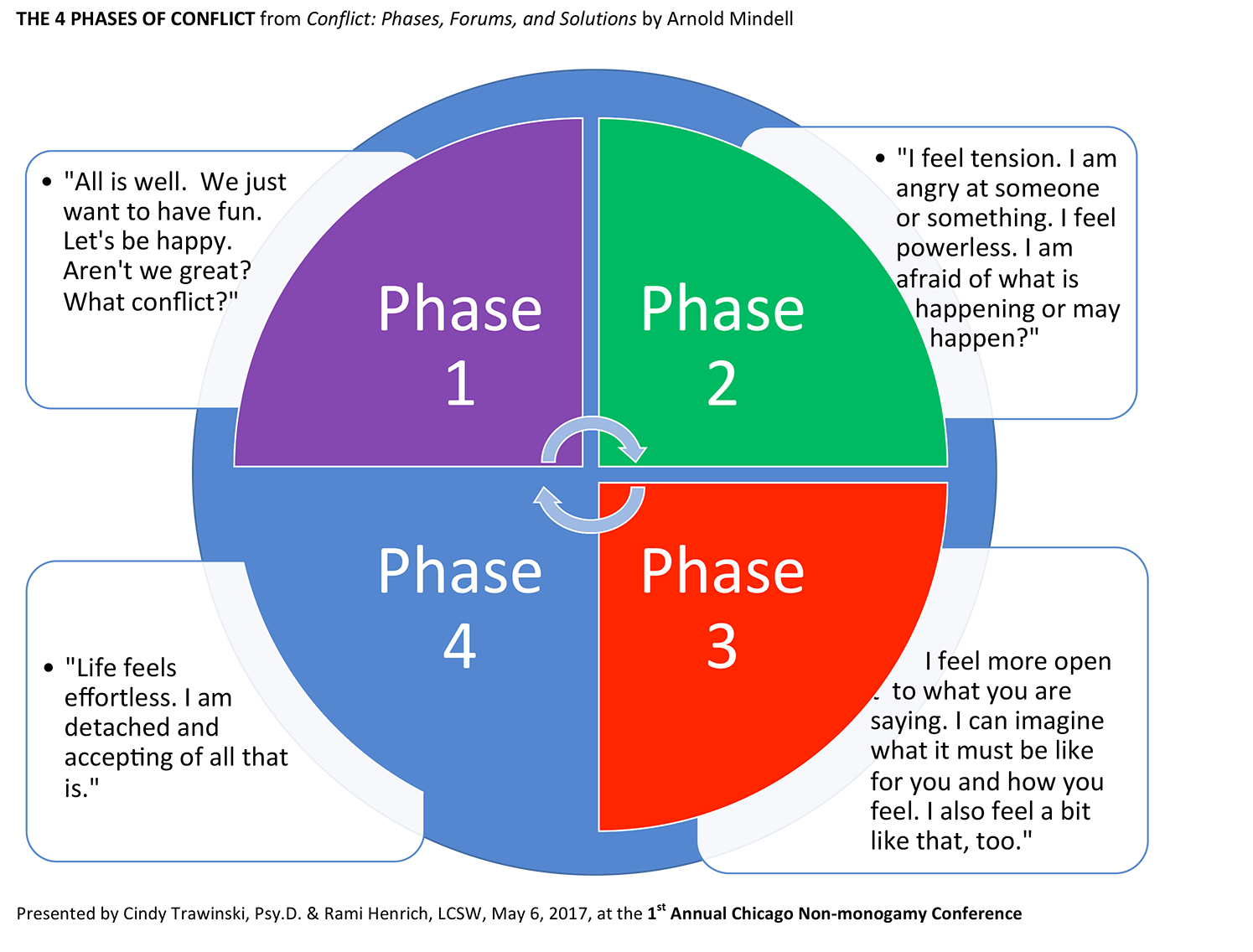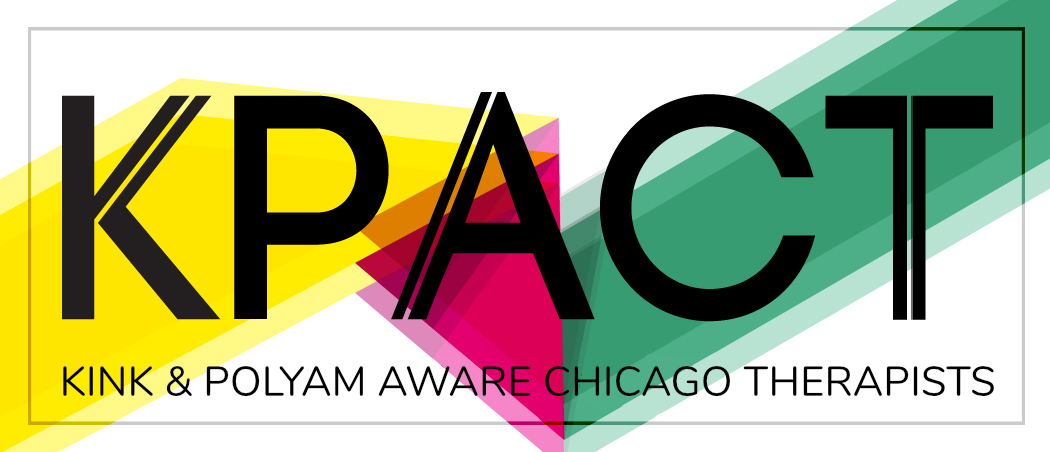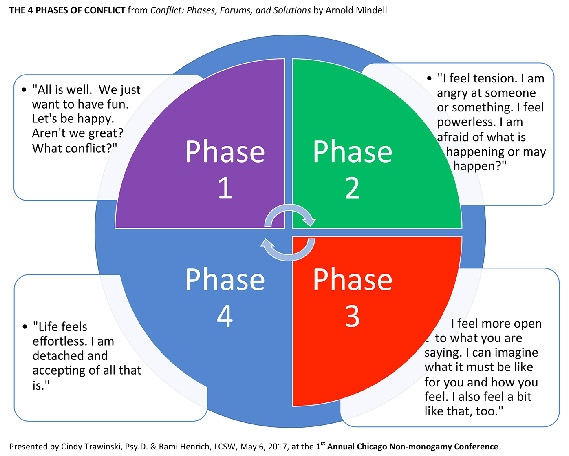
Ever had conflict?
Most people have had more conflict than they care to recall. Conflict is important to everyone and every relationship but when you are in a multi-partnered relationship good conflict skills become even more critical. On May 6, 2017, Rami Henrich, LCSW and I presented a workshop on applying the principle of deep democracy to everyday conflicts in relationships at the 1st Annual Chicago Consensual Non-monogamy Conference.
What is deep democracy?
Deep democracy is Arnold Mindell’s idea that all voices in relationships, families and communities are important and needed for the wholeness and well being of the of the larger group. Deep democracy “addresses the perennial conflict related to marginalization by emphasizing the value of all viewpoints and the necessity for them each to find expression.” 1 In other words, deep democracy means being open to all viewpoints, experiences, and emotions, not just the ones that we agree with, but also those that are uncomfortable, unknown, or frightening. This is a difficult thing to achieve, but it is worth the effort because “if change occurs by devaluing one state and throwing it out in favor of another, the part that has been thrown out may come back to assert itself and sabotage what has already been accomplished.” 2 Ignoring one viewpoint in favor of another only polarizes the two sides and moves them farther apart, but deep democracy tries to honor “that special feeling of belief in the inherent importance of all parts of ourselves and all viewpoints in the world around us.” 3
Conflict in Everyday Life
Many of us notice that we fall into a pattern of response to relationship conflict that recycles again and again, without providing an opening to approach our partner(s) from a new perspective or with new feelings. Gaining a fresh awareness of ourselves and our partner(s) in conflictual situations helps relieve the tension and brings in new possibilities.
Mindell’s work with conflict has evolved overtime but central to his approach is the idea of finding momentary common ground and personal resonance with our partner(s). In his recent book, Conflict: Phases, Forums & Solutions, he describes four phases of conflict. The illustration below captures some of the thoughts or feelings we may have in different phases of conflict.
One way we commonly look at conflict is to think of it as a struggle between incompatible points of view, needs or wishes. We may have a tendency to focus on the issue instead of our experience and our partner’s experience. Or we may focus on our own or partner’s psychology instead of the experience we each may be having. These approaches can lead to polarization, trying to convince, compromise, cajole or argue our way to a conclusion or solution. And sometimes that satisfies us. But when these strategies don’t satisfy us, we need another way of thinking about conflict and new skills for creating resolution together.
The 4 Phases of Conflict

These phases don’t always follow each other sequentially and we may experience some only fleetingly.
PHASE 1 may be associated with being happy. This phase is often what our culture focuses most on attaining but it is only a temporary state. In Phase 1, we don’t seem to have problems, disagreements or tensions.
PHASE 2 is what many people identify as conflict. In Phase 2, the tension surfaces. arguments, disagreements, frustrations, etc… arise here. We tend to lose sight of the phases that precede and follow this phase of tension and upset. When you are stuck in Phase 2, you may want to get some help or support (i.e therapy) but you could also work on the situation yourself (see exercise below).
We often sense that “role switching” of PHASE 3 is needed or wanted but have trouble being able to deeply understand and feel into others’ experiences of the conflict we are in. Role switching is imagining or feeling how another sees and experiences the problem and embracing (even if briefly) their point of view. This often relieves the tension momentarily and allows us to find common ground or approach the other from a less polarized point of view. We sometimes need outside help or support (therapy, counseling, meditation) to reach this phase but there are tools and skills we can learn and develop to help ourselves into this phase (the exercise below is one way).
PHASE 4, the feelings of relaxed detachment and sensing how the universe moves you, is not only a phase but also the background of openness and acceptance behind all the phases.
Why 4 Phases?
Recognizing all the phases of conflict is especially important to people in non-monogamous relationships for at least 3 reasons:
1. It helps us recognize that each of our relationships are in different phases. One relationship is not better or worse than another.
2. It reminds us that these are fluid states or phases. They are changing, not fixed. This can reduce tension and frustration and give us a sense of what to expect.
3. If you are providing support to others in Phase 2, knowing there are phases may help you remain neutral and facilitate all parties.
So, the next time you find yourself in Phase 2 conflict and tension, try remembering it is a part of bigger process and then practice role switching or use the exercise below to try to find a new perspective.
Exercise: 5-Minute Communing Practice
To reduce and resolve conflict in your relationship(s), practice this process alone or with a partner.
A. Choose a conflict and ask yourself, or your partner, coach your partner on how to play the “disturbing one” — the person with whom you have conflict. What do they do or say that upsets you? What is it that bothers you about the situation or relationship?
B. Now, identify and appreciate the real-world differences between you. How are you different from the “disturbing one”? Imagine defending yourself and/or getting encouragement to defend your viewpoint.
C. Now “commune”; feel and dream into the other (the disturbing one) until you can be them, until you understand the other’s feelings as feelings you recognize in yourself. Sense how you are “disturbing one.”
D. Remembering this “communing” experience, commune-icate with the “disturbing one” (or your partner playing them), sharing your similarity to them and understanding of where feelings come from.
E. Finally, ask your partner to give you feedback about your ability to “commune-icate.”
With practice, this 5-minute process can reduce conflict. If this process takes more than 5 minutes, repeat the exercise until you can do it more easily, and more quickly.
THIS EXERCISE AND OTHERS CAN BE FOUND IN CONFLICT: PHASES, FORUMS & SOLUTIONS BY ARNOLD MINDELL (2017)
1 Menken, 2001, p. 14
2 Diamond & Jones, 2004, p. 36
3 Mindell, 1993, p. 5

